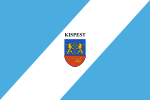Határ út metro station
European rapid transit stubsHungarian building and structure stubsHungarian railway station stubsHungary transport stubsM3 (Budapest Metro) stations ... and 2 more
Railway stations opened in 1980Transit centers in Hungary

Határ út is a station on the M3 (North-South) line of the Budapest Metro. Near the station, there are several tram and bus terminus, and a shopping centre. Határ út station named after the adjacent street Határ út, which literally means "(City) Border Street". Before the formation of Greater Budapest it was the border of Budapest Capital. The station was opened on 20 April 1980 as part of the extension from Nagyvárad tér to Kőbánya-Kispest.
Excerpt from the Wikipedia article Határ út metro station (License: CC BY-SA 3.0, Authors, Images).Határ út metro station
Ferde utca, Budapest József Attila-lakótelep
Geographical coordinates (GPS) Address Phone number Website Nearby Places Show on map
Geographical coordinates (GPS)
| Latitude | Longitude |
|---|---|
| N 47.4647 ° | E 19.1264 ° |
Address
Ibis Budapest Citysouth Hotel
Ferde utca 1
1091 Budapest, József Attila-lakótelep
Hungary
Open on Google Maps










